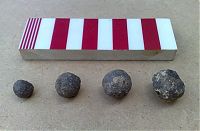Talking Old Balls or The use of Firelocks in Georgian London
- By: David Harrison |
- Aug 15, 2008
- Share
- del.icio.us

During the course of the project we’ve had some interesting unstratified finds discovered by metal detectorists from the Society of Thames Mudlarks, including these flintlock pistol and musket balls.
As the sort of bloke who reads far too much Napoleonic – era fiction, combined with a general geekiness for historic weaponry, I decided to take a look at the four examples shown here.
Taking into account that smoothbore muzzle loaders leave a gap between barrel and shot, known as ‘windage’, and the roughly-cast shape of the shot, I have been able to determine roughly the sort of weapon these bullets were cast for.
The ball on the left is approximately 10mm in diameter. This would fit a very small bore muzzleloader, such as a pistol. Anyone in the 18th or early 19th centuries with pretensions to being a gentleman would be likely to own a brace of pistols.
The second ball from the left is about 13mm in diameter, which would seem to conform with the .62in calibre of an 18th Century English military pistol, such as the Dragoon or Land Pattern pistol.
The two balls on the right, with diameters of 17mm and 20mm respectively, would appear to be cast for the ubiquitous .75 calibre British service musket, commonly known as the ‘Brown Bess’.
In its many variants, this was the main weapon of the British Army between 1722 and 1838, serving every British military campaign of that era, including the Napoleonic Wars and the American Revolution. Many of these guns were manufactured nearby at the Tower of London, and would have been inscribed with “TOWER” on their lock-plates. The rightmost ball has been somewhat flattened, suggesting it has been fired.
These finds would seem to confirm a historical reference in ‘The Economist and General Adviser’ of December 11, 1824, to the use of the Tenter Ground, which covered the area North of South Tenter Street prior to the 19th century, as a parade ground by militia troops in the late 18th century,
Harnessed and armed, big with valorous loyalty, the garden of the Tenter Ground became the field of Mars, and the spring and summer flowers yielded to the flowers of chivalry. But of all the gallant days for Goodman’s Fields, the 21st of June in the year 1799 must be remembered ; Prescott and Leman streets were filled with volunteers of the east waiting to be reviewed by his late majesty. On that day, not less than fifty thousand men clothed armed and accoutred at their own expense to defend their soil had been reviewed in parts of London by their Sovereign ; but, alas, for the volunteers assembled in Goodman’s Field mistake happened in the marshalling, which led to the most ludicrous result the king was looking after the soldiers and the soldiers were seeking the king ; it was a race between loyalty and majesty.
- (1)


· Stuart Eve · Aug 18, 01:54 PM